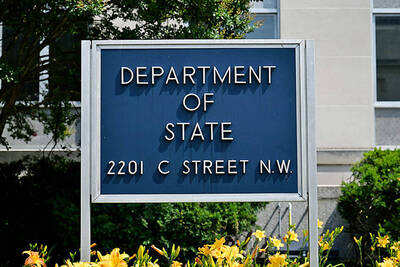Hon Hai Precision Industry Co (鴻海精密) yesterday debuted three electric vehicle (EV) prototypes to great fanfare at its Tech Day event at the Taipei Nangang Exhibition Center.
The prototypes of sports utility vehicle Model C, luxury sedan Model E and electric bus Model T were developed by Foxtron Vehicles Technologies Co (鴻華先進), a joint venture between Hon Hai and Yulon Motor Co (裕隆汽車).
The Model C and Model E are to be initially sold under the Yulon-affiliated Luxgen Motor Co (納智捷汽車) and China Motor Corp (中華汽車) brands when they hit the market, Hon Hai chairman Young Liu (劉揚偉) said.

Photo: Fang Pin-chao, Taipei Times
The company expects the electric vehicle business to contribute to revenue as early as next year, Liu said.
“We anticipate significant revenue contribution by 2023, and for EVs to be Hon Hai’s next trillion NT business in five years,” he said.
Although Hon Hai has aggressively trumpeted its EV ambitions since October last year and announced many partnerships, including with US firm Fisker Inc, Lordstown Motors Corp and European auto giant Stellantis NV, yesterday was the first time it showed the fruits of its labor.
The 4.64m-long Model C features a sleek, spacious and power-saving design, while the Model T bus is equipped with a rigid body and a 400 watt-hours battery, fully meeting the standards set by the US Federal Transit Administration, the company said.
The Model E luxury sedan, jointly developed with Italian design firm Pininfarina SpA, can accelerate from 0 to 100kph in 2.8 seconds, and generates 750 horsepower, with a full range of 750km, it said.
The three vehicles were built on Hon Hai’s EV open platform known as MIH. The “MIH alliance” is an open standard founded by Hon Hai with the aim of allowing Taiwanese EV component makers to cooperate with each other with the ambition to become “the Android of EVs.” It was spun off as an independent entity in July.
The price of the Model C would be “under NT$1 million [US$35,695],” Liu said, but did not disclose the prices for the other two models.
The prototypes are demonstration models for customers, who can have them customized according to their specifications and design, he said.
Yulon Motor chairperson Lilian Chen (嚴陳莉蓮), who appeared on stage in a Model C, said the three EVs were built in just one year, a display of Taiwan’s potential and strengths in automobile research and development.
While the physical vehicles were the star of the show yesterday, Liu said that Hon Hai is driving its EV business into “a software-defined enterprise.”
“As the electric vehicle business develops and matures, Hon Hai will set up a software R&D [research and development] center with more than 2,500 engineers within three years,” he said. “We welcome those who are interested in the field of electric vehicle software.”
Vice Premier Shen Jong-chin (沈榮津) said the Model T is likely to start service in Kaohsiung next year, once it passes the quality and safety test of the Ministry of Transportation and Communications, paving the way for it to break into overseas markets
Former Hon Hai chairman and company founder Terry Gou (郭台銘), who drove a Model E sedan onto the stage, said the EVs were the “best birthday present ever.”
He turned 71 yesterday.
“This is the best gift I have ever received for my birthday,” he said.

MISINFORMATION: The generated content tends to adopt China’s official stance, such as ‘Taiwan is currently governed by the Chinese central government,’ the NSB said Five China-developed artificial intelligence (AI) language models exhibit cybersecurity risks and content biases, an inspection conducted by the National Security Bureau (NSB) showed. The five AI tools are: DeepSeek, Doubao (豆包), Yiyan (文心一言), Tongyi (通義千問) and Yuanbao (騰訊元寶), the bureau said, advising people to remain vigilant to protect personal data privacy and corporate business secrets. The NSB said it, in accordance with the National Intelligence Services Act (國家情報工作法), has reviewed international cybersecurity reports and intelligence, and coordinated with the Ministry of Justice Investigation Bureau and the National Police Agency’s Criminal Investigation Bureau to conduct an inspection of China-made AI language

LIMITS: While China increases military pressure on Taiwan and expands its use of cognitive warfare, it is unwilling to target tech supply chains, the report said US and Taiwan military officials have warned that the Chinese People’s Liberation Army (PLA) could implement a blockade within “a matter of hours” and need only “minimal conversion time” prior to an attack on Taiwan, a report released on Tuesday by the US Senate’s China Economic and Security Review Commission said. “While there is no indication that China is planning an imminent attack, the United States and its allies and partners can no longer assume that a Taiwan contingency is a distant possibility for which they would have ample time to prepare,” it said. The commission made the comments in its annual

BOOST IN CONFIDENCE: The sale sends a clear message of support for Taiwan and dispels rumors that US President Donald Trump ‘sold out’ the nation, an expert said The US government on Thursday announced a possible sale to Taiwan of fighter jet parts, which was estimated to cost about US$330 million, in a move that an expert said “sends a clear message of support for Taiwan” amid fears that Washington might be wavering in its attitude toward Taipei. It was the first announcement of an arms sale to Taiwan since US President Donald Trump returned to the White House earlier this year. The proposed package includes non-standard components, spare and repair parts, consumables and accessories, as well repair and return support for the F-16, C-130 and Indigenous Defense Fighter aircraft,

CHECKING BOUNDARIES: China wants to disrupt solidarity among democracies and test their red lines, but it is instead pushing nations to become more united, an expert said The US Department of State on Friday expressed deep concern over a Chinese public security agency’s investigation into Legislator Puma Shen (沈伯洋) for “secession.” “China’s actions threaten free speech and erode norms that have underpinned the cross-strait ‘status quo’ for decades,” a US Department of State spokesperson said. The Chongqing Municipal Public Security Bureau late last month listed Shen as “wanted” and launched an investigation into alleged “secession-related” criminal activities, including his founding of the Kuma Academy, a civil defense organization that prepares people for an invasion by China. The spokesperson said that the US was “deeply concerned” about the bureau investigating Shen